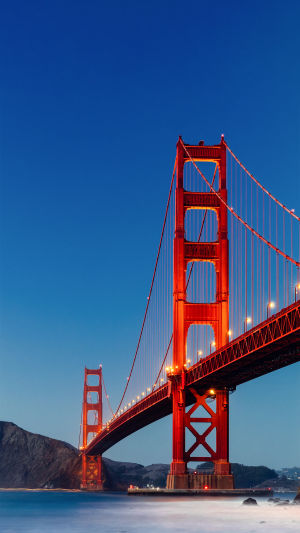Hello, Lykkers! The Golden Gate Bridge is more than just a means of crossing San Francisco Bay; it is an emblem of architectural ingenuity and aesthetic beauty that captures the imagination of millions.
Spanning 1.7 miles and connecting the city of San Francisco to Marin County, this iconic structure stands as a testament to human innovation, determination, and artistic vision.
Since its completion in 1937, the Golden Gate Bridge has become a symbol of San Francisco and an engineering marvel recognized around the world. Whether you are a first-time visitor or a seasoned admirer, this legendary landmark continues to inspire awe and admiration at every glance.
<h3>History and Construction</h3>
<b>Concept and Design</b>
<b>Early Proposals:</b> The idea of a bridge connecting San Francisco to Marin County was first proposed in the 1870s. However, it wasn't until the early 20th century that serious planning began.
<b>Chief Engineer:</b> Joseph Strauss, a bridge engineer, became the chief engineer of the project. He initially envisioned a hybrid cantilever-suspension bridge but later agreed to a full suspension design, thanks to the influence of consulting engineers Leon Moisseiff and Charles Alton Ellis.
<b>Final Design:</b> Irving Morrow, an architect, contributed to the Art Deco design and the distinctive International Orange color.
<h3>Construction Milestones</h3>
<b>Start Date:</b> Construction began on January 5, 1933.
<b>Challenges:</b> Workers faced harsh weather conditions, strong currents, and the Great Depression. Despite these challenges, the bridge was completed ahead of schedule.
<b>Completion:</b> The Golden Gate Bridge was completed on April 19, 1937, and opened to pedestrians on May 27, 1937. Vehicles were allowed to cross the following day.
<h3>Architectural and Engineering Marvel</h3>
<b>Specifications</b>
<b>Length:</b> 1.7 miles (2.7 kilometers).
<b>Height:</b> The towers rise 746 feet (227 meters) above the water.
<b>Main Span:</b> The main span is 4,200 feet (1,280 meters), making it the longest suspension bridge span in the world at the time of its completion.
<b>Cables:</b> The two main cables are 7,650 feet (2,332 meters) long and contain 80,000 miles (129,000 kilometers) of wire.
<b>Construction Techniques</b>
<b>Foundation:</b> The south tower is anchored in a massive concrete foundation built on bedrock beneath the bay. The north tower stands on solid ground.
<b>Suspension:</b> The main cables were spun on site using a process known as "air spinning," which involved looping thin wires back and forth across the bay to form the thick cables.
<h3>Cultural and Economic Impact</h3>
<b>Cultural Significance</b>
<b>Symbol of San Francisco:</b> The Golden Gate Bridge has become an iconic symbol of San Francisco and the United States, appearing in countless films, photographs, and artworks.
<b>Tourism:</b> It attracts millions of visitors annually who come to walk or bike across the bridge, visit the nearby Golden Gate National Recreation Area, or simply admire the stunning views.
<b>Economic Impact</b>
<b>Transportation:</b> The bridge plays a crucial role in regional transportation, facilitating the movement of people and goods between San Francisco and the counties to the north.
<b>Jobs and Growth:</b> The construction of the bridge provided jobs during the Great Depression and continues to support the local economy through tourism and maintenance.
<h3>Practical Information for Visitors</h3>
<b>Getting There</b>
<b>Location:</b> The bridge connects San Francisco to Marin County. The San Francisco side starts near the Presidio, while the Marin County side connects to Highway 101.
<b>Public Transport:</b> Several bus routes and shuttles serve the Golden Gate Bridge. Visitors can also use ride-sharing services or bike rental companies.
<h3>Visiting Tips</h3>
<b>Walking and Biking:</b> Pedestrians and cyclists can access the bridge via dedicated pathways. The eastern sidewalk is usually open to pedestrians, while the western sidewalk is reserved for cyclists during designated hours.
<b>Visitor Centers:</b> The Golden Gate Bridge Welcome Center offers exhibits, a gift shop, and information on the bridge's history and engineering. The Round House Café provides refreshments and additional viewpoints.
<b>Best Times to Visit:</b> Early morning or late afternoon offers the best lighting for photographs and fewer crowds. Fog is common in the summer months, adding a mystical quality to the experience.
<h3>Conclusion</h3>
The Golden Gate Bridge stands as a marvel of engineering, an icon of American culture, and a testament to human determination. Its striking beauty and historical significance make it a must-visit landmark for travelers from around the world. Whether you walk, bike, or simply gaze upon it from afar, the Golden Gate Bridge promises an unforgettable experience.
Golden Gate Bridge - San Francisco, USA 🇺🇸 - by drone [4K]
Video by Drone Snap





